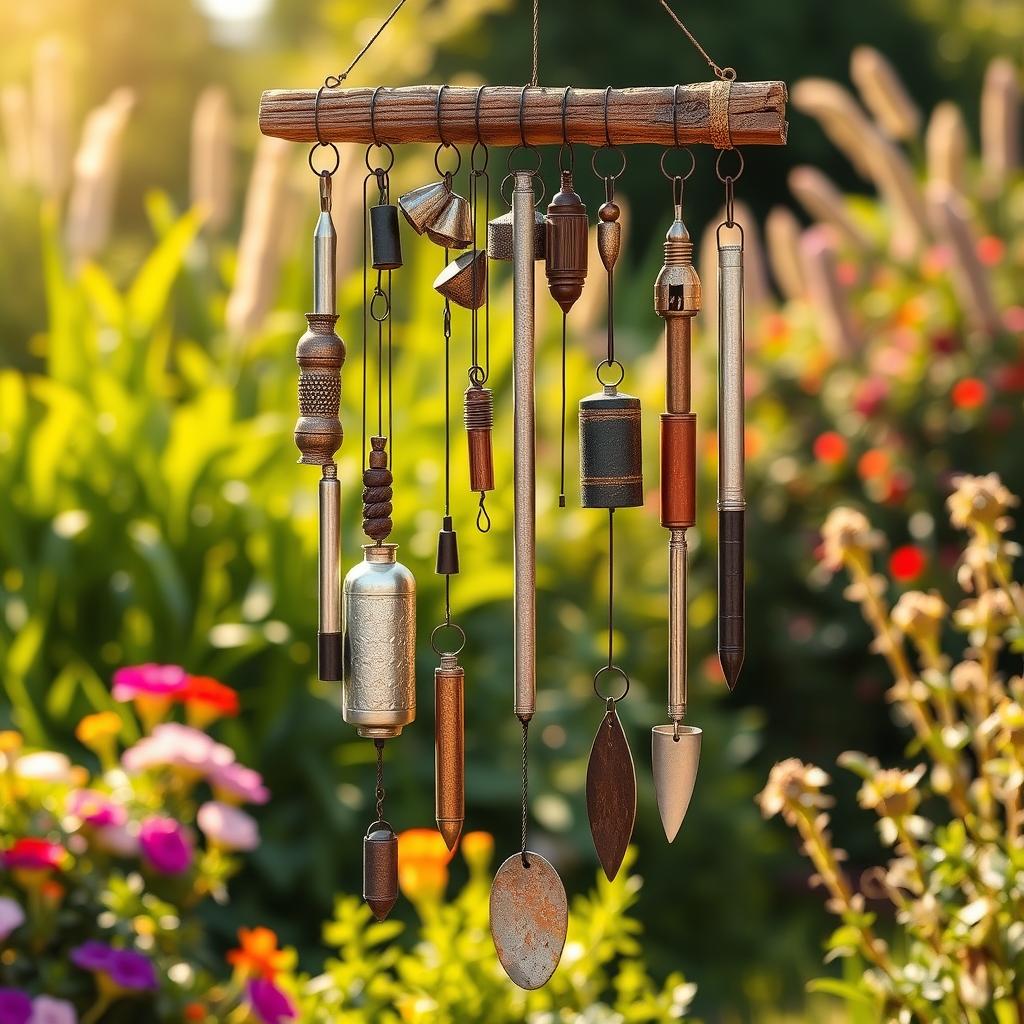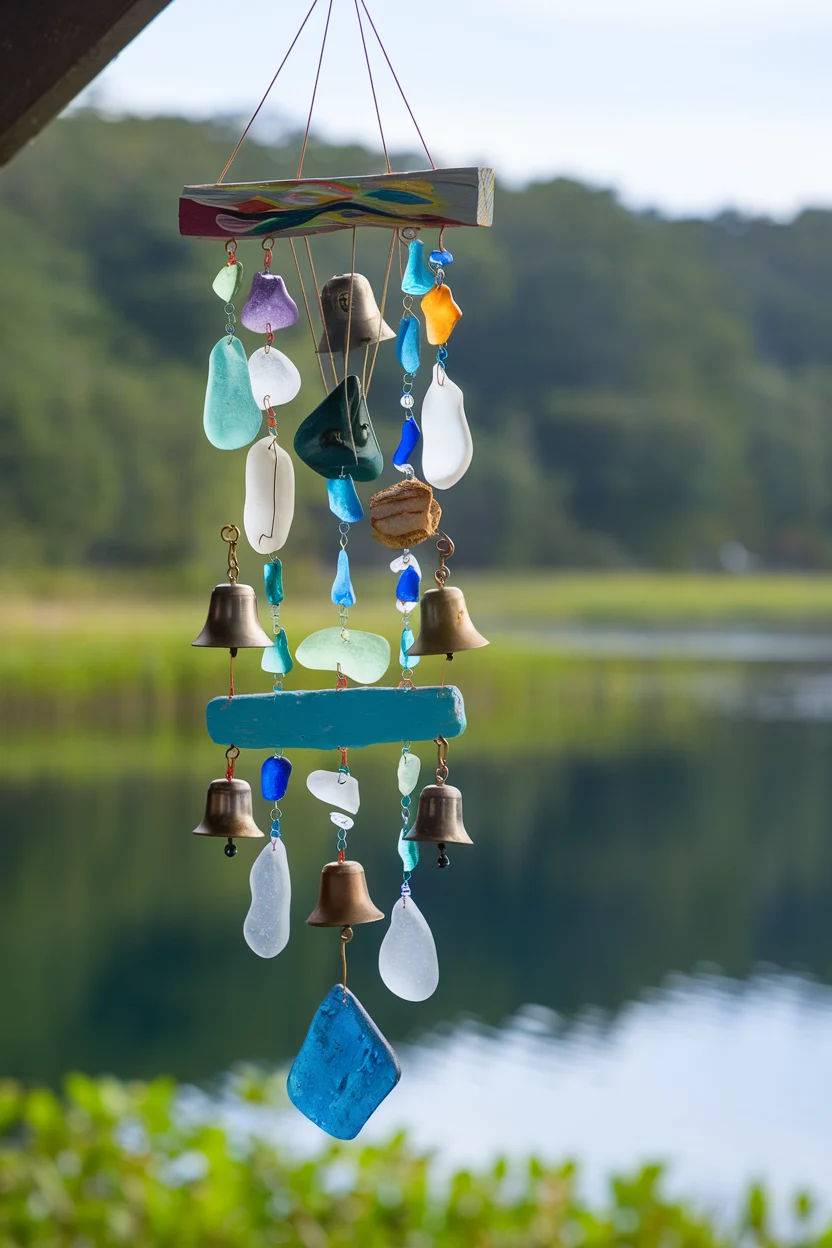This website contains affiliate links. As an Amazon Associate, I earn from qualifying purchases. The content on this website was created with the help of AI.
Welcome to a fun journey of creativity that will make your garden come alive! Wind chimes are more than just decorations. They tell stories through sound, turning outdoor spaces into peaceful havens. Whether you’re experienced or new to DIY, these projects will encourage you to create unique sounds that show off your garden’s spirit.
Making your own wind chimes is a great way to make your garden truly yours. With a few basic materials and some creativity, you can create beautiful sounds that match your style. These sounds will add a calming touch to your garden.
Key Takeaways
- Discover creative ways to make personalized wind chimes
- Learn how different materials impact sound quality
- Explore eco-friendly upcycling techniques for garden decor
- Understand the basics of wind chime construction
- Gain inspiration for unique garden sound installations
Essential Materials and Tools for Creating Wind Chimes
Making your own wind chimes is a fun project that brings creativity and skill together. Before starting, it’s important to have the right materials. This will make your DIY wind chimes project a success and beautify your outdoor area.
Basic Tools You’ll Need
To start your wind chime project, you’ll need some basic tools. You’ll need a drill, wire cutters, pliers, a measuring tape, and sandpaper. A hammer and work gloves are also useful for handling different materials.

Types of Chime Materials
The core of a wind chime is its materials. You can pick from copper pipes, aluminum tubes, bamboo sticks, or even recycled items like old keys or silverware. Metal materials usually make a clear sound, while wood creates softer tones for your garden.
Recommended String and Hanging Materials
Choose strong materials for hanging your wind chimes. Nylon fishing line is a good choice because it’s strong and almost invisible. For the base, consider a wooden hoop, metal ring, or a sturdy branch. The materials you pick will affect how your wind chimes look and sound.
Pro tip: Try mixing different materials to get unique sounds and designs that match your garden’s look.
Why Wind Chimes Enhance Your Garden’s Atmosphere
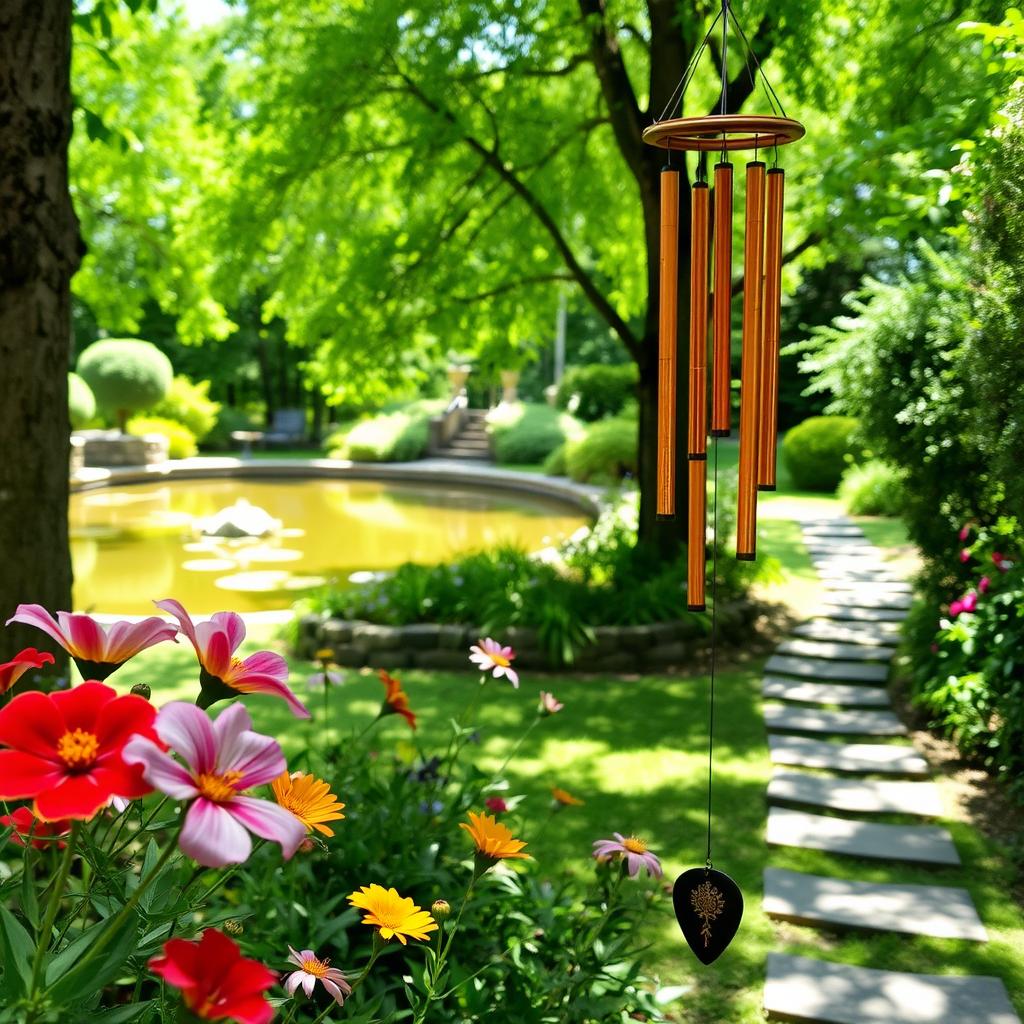
Turning your outdoor space into a haven is simple. Wind chimes add magic, creating a soothing sound that takes you to a peaceful place. They are more than decorations; they are instruments that play with the wind.
Wind chimes do more than just look good. They have a long history and offer a special experience. They can block out unwanted sounds. Different materials like metal, bamboo, and ceramic make different sounds, helping to make your garden quiet.
Where you put your wind chimes matters a lot. Hanging them near plants helps block out noise. Experts say to hang them at eye level or higher for the best sound.
Each material has its own sound. Bamboo chimes sound tropical, while metal ones can be high-pitched or deep. Glass chimes add beauty and sound, making them great for gardens.
Choosing and placing wind chimes right can make your garden a place of peace and creativity.
Understanding Wind Chime Acoustics for Better Design
Creating the perfect wind chimes is an art that mixes creativity with science. You start by learning how sound is made and changed with different materials and setups.
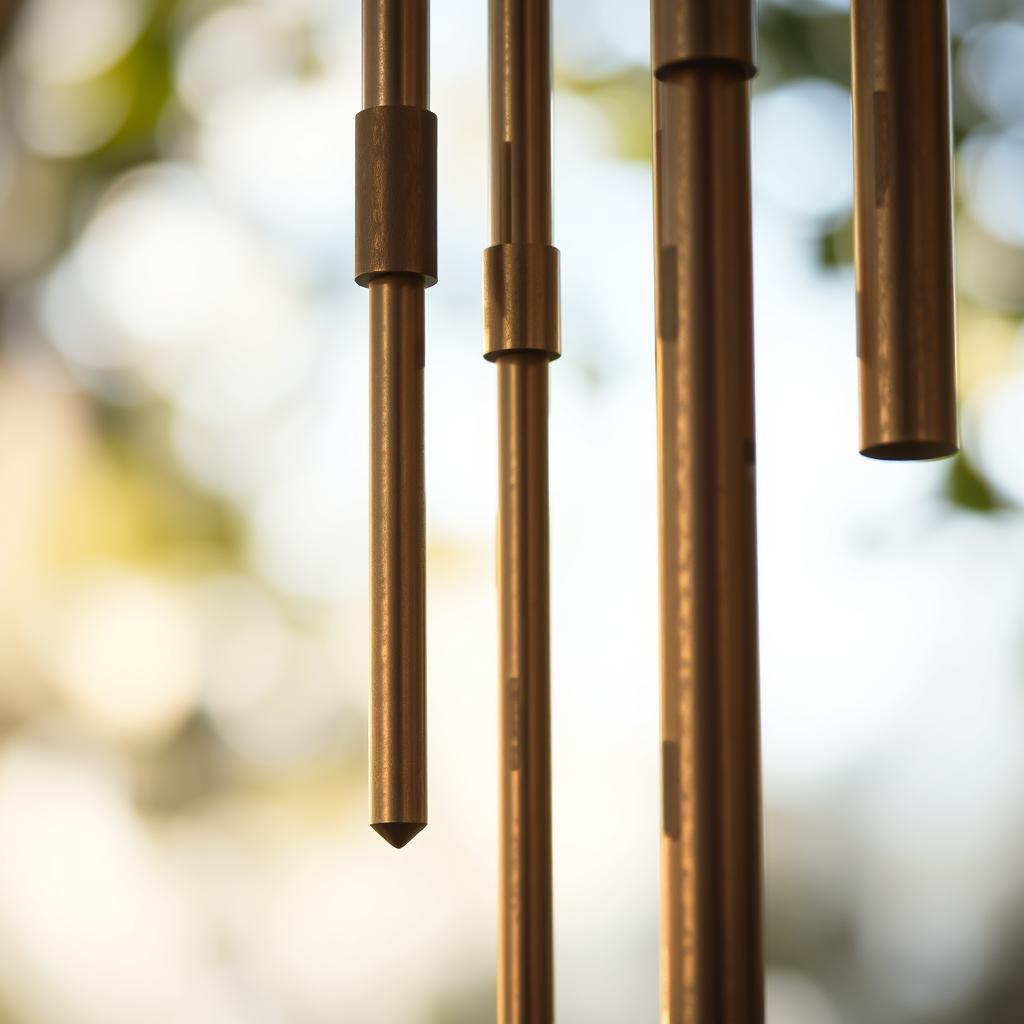
Wind chimes are more than just decorations. Each one is a special sound maker that turns soft breezes into beautiful music. The sound of wind chimes depends on several key things you can change when designing them.
Sound Production Basics
Wind chime acoustics start with vibration. When wind hits the chimes, they start to vibrate, making sound waves that move through the air. The material, length, and thickness of each chime affect its sound.
Material Impact on Sound Quality
Different materials make different sounds. Aluminum chimes sound bright and clear, while brass sounds warmer and deeper. Copper is in the middle, with sounds that are rich and mellow, changing your garden’s sound.
Length and Thickness Considerations
The length and thickness of wind chimes affect their pitch and volume. Longer chimes sound lower, and shorter ones sound higher. Thicker tubes make sounds that last longer, letting you control your wind chime’s sound.
10 DIY Wind Chimes Ideas for Your Garden Space
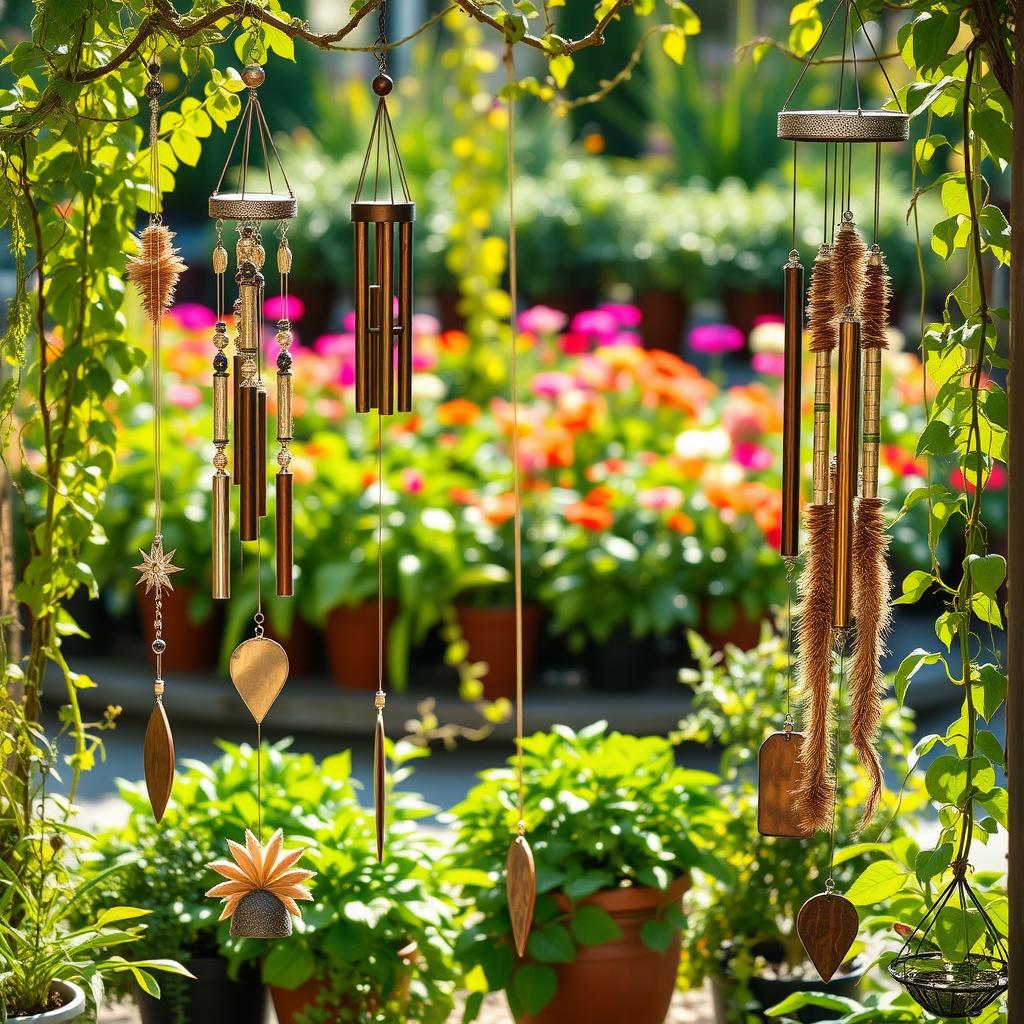
Turn your garden into a musical haven with these DIY wind chime ideas. They’re perfect for both seasoned crafters and beginners. These projects help you add a personal flair to your outdoor area.
Begin with items you already have at home. Old keys, CDs, and silverware can be turned into beautiful wind chimes. Coastal lovers might enjoy making seashell wind chimes that remind them of the beach.
Try using eco-friendly materials like driftwood, glass bottles, and plastic lids. These wind chimes are not only pretty but also good for the planet. They’re a great way for families to spend a weekend together, making unique decorations for the garden.
Get creative with your materials. Mix metal pipes with wood or use colored glass for an ombre effect. The sky’s the limit when you let your imagination run wild with garden wind chimes.
For those who love crafting, try different ways to hang your wind chimes. Use chandelier crystals, beads, or natural items like small branches. The best garden ideas come from expressing yourself and being open to new things.
Upcycled Materials for Eco-Friendly Wind Chimes
Make your garden a green haven with upcycled wind chimes. These creations give old items a new life. They turn trash into music and show off your green thumb.

Upcycled wind chimes are a fun way to reuse materials. They turn trash into treasures that tell a story. Your garden will be a reflection of your love for the planet.
Repurposed Kitchen Items
Your kitchen is full of wind chime materials. Old silverware, mismatched utensils, and worn-out colanders can become beautiful sound sculptures. Metal spoons, whisk attachments, and vintage cookie cutters can create unique chiming music that adds character to your garden space.
Vintage and Antique Elements
Antique keys, broken jewelry, and vintage hardware can transform into elegant wind chimes. These pieces carry history and charm, creating a conversation piece that adds nostalgia to your outdoor environment. A collection of old skeleton keys or vintage brass fixtures can produce delightful, resonant tones.
Natural Found Objects
Nature offers amazing materials for eco-friendly wind chimes. Driftwood, sea glass, smooth river stones, and dried seed pods can craft an organic, earthy musical piece. Collect these treasures during walks and let them sing with the garden breeze, creating a connection between your outdoor space and the natural world.
Step-by-Step Guide to Assembling Your First Wind Chime
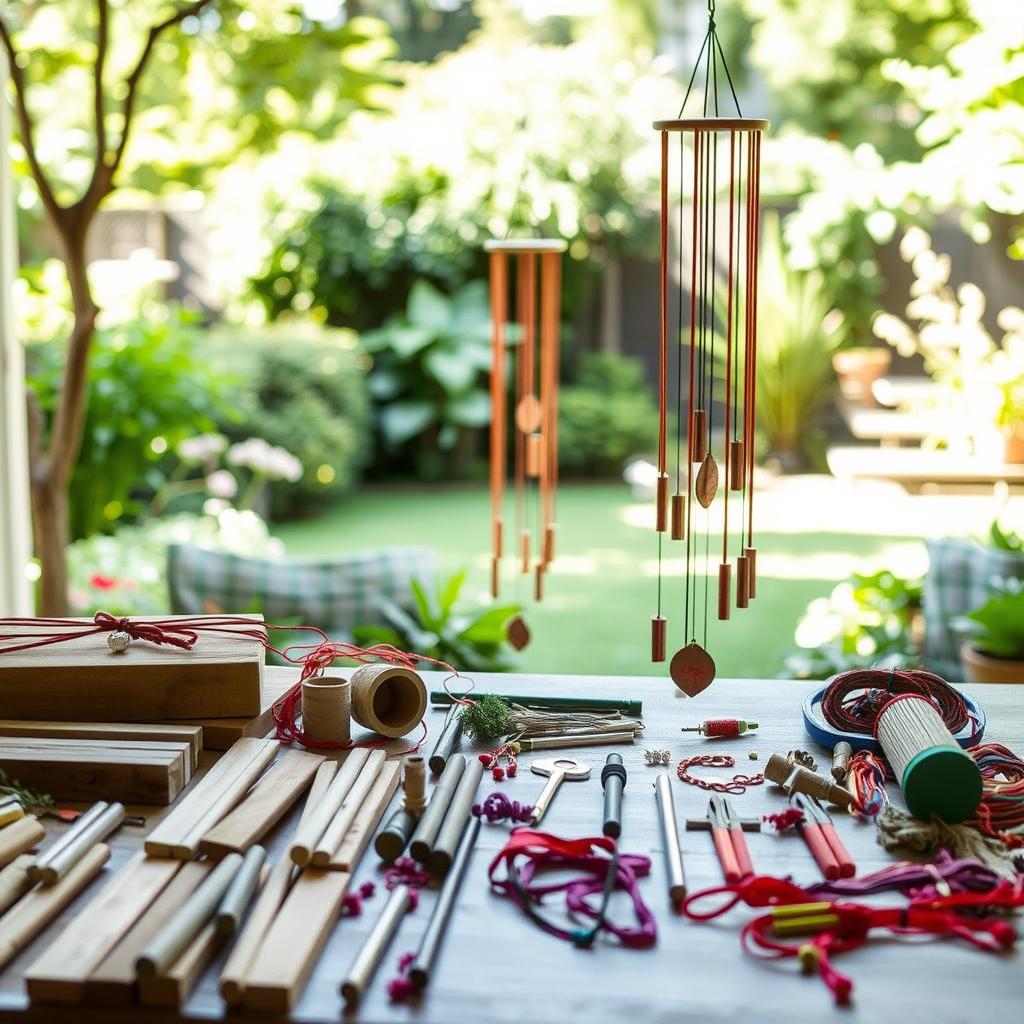
Making your own DIY wind chimes is a fun project. It turns simple items into a musical garden feature. First, collect your materials. For a basic four-chime setup, you’ll need galvanized steel pipes, thick braided rope, and quick links for connections.
Getting the measurements right is crucial. Cut your metal pipes with care. Try to keep the length difference under a foot between the longest and shortest chimes. A tip: mark your suspension points at 22.4% of each pipe’s length from the top for the best sound.
Use a 24×24 inch plywood base for stability when assembling. Attach your chimes with 16-gauge galvanized metal wire. This lets each tube swing freely. Adding vintage keys can make your wind chimes unique – smaller keys sound higher, while larger keys sound deeper.
For hanging, use strong quick links and a dog chain. A 4 oz pyramid fishing sinker helps balance. Hang your wind chimes where they catch gentle breezes for beautiful sounds.
Pro tip: Try different key sizes and materials to make your wind chimes sound special!
Creative Design Tips for Unique Wind Chimes
Making wind chimes is more than a hobby; it’s an art that makes your garden special. With the right design, you can make wind chimes that show off your style and personality.
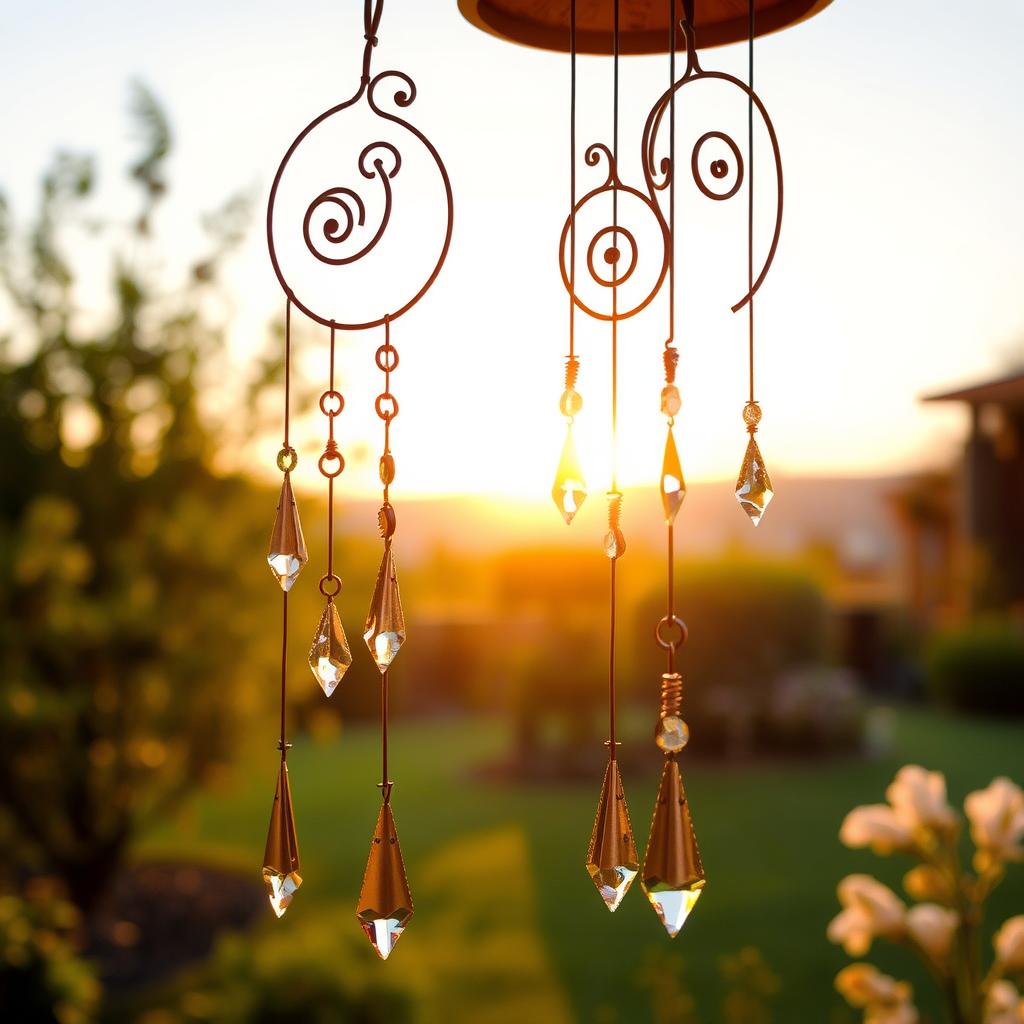
DIY fans are getting creative with wind chime designs. About 30% of craft lovers focus on home decor, and wind chimes are a favorite. Your design can turn these garden accessories into stunning pieces of art.
Color Palette Magic
Choosing the right colors can change your wind chimes. Pick colors that stand out in your garden. Copper wind chimes, which are now 20% more popular, shine beautifully in sunlight.
Pattern Play
Try different patterns to add interest. Mix materials like sea glass with metal or wood. Asymmetrical designs can give your wind chimes a unique touch.
Decorative Elements
Add special touches to make your wind chimes stand out. Use beads, shells, or recycled items for texture and style. About 70% of DIY crafters use old items, making your wind chime creative and green.
Let your imagination run wild when making wind chimes. Whether for relaxation or art, your design will add music and beauty to your garden.
Maintenance and Weather Protection Tips
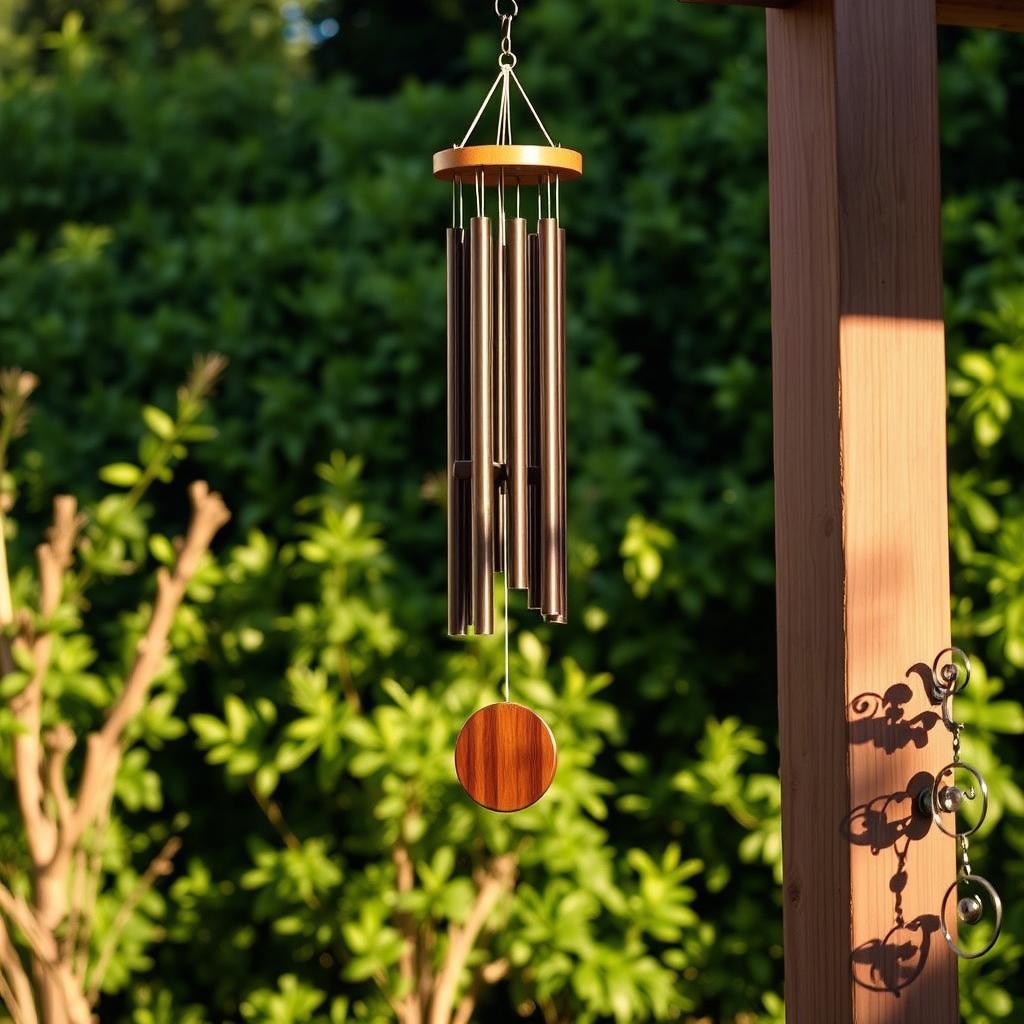
Keeping your wind chimes in top shape means protecting them from harsh weather. Regular care ensures they stay beautiful and sound great. Simple maintenance steps can make your wind chimes last for many years.
Begin by picking materials that can handle the weather. Bamboo, metal, and ceramic are good choices. Metal chimes are best for outdoors because they’re strong. A protective coat, like Krylon Dual Superbond paint, can also help them last longer.
Seasonal upkeep is key. Clean your wind chimes every 1-2 months to remove dirt and debris. Use Minwax Wood Finishing Cloths on wooden parts to keep them looking good and protected.
Think about where you’ll hang your wind chimes. Place them at eye level (5-6 feet high) with sturdy hooks for heavy chimes. Stay away from busy spots and areas with strong winds. This helps avoid damage and keeps them safe.
If you like DIY, using recycled materials is a smart move. It’s cheaper and makes your decor special. Regular checks and quick fixes keep your wind chimes sounding lovely in your garden.
Best Locations to Hang Your Wind Chimes
Creating the perfect melody in your garden requires thoughtful wind chimes placement. Your outdoor space can transform into a symphony of sounds when you understand the nuances of strategic positioning.
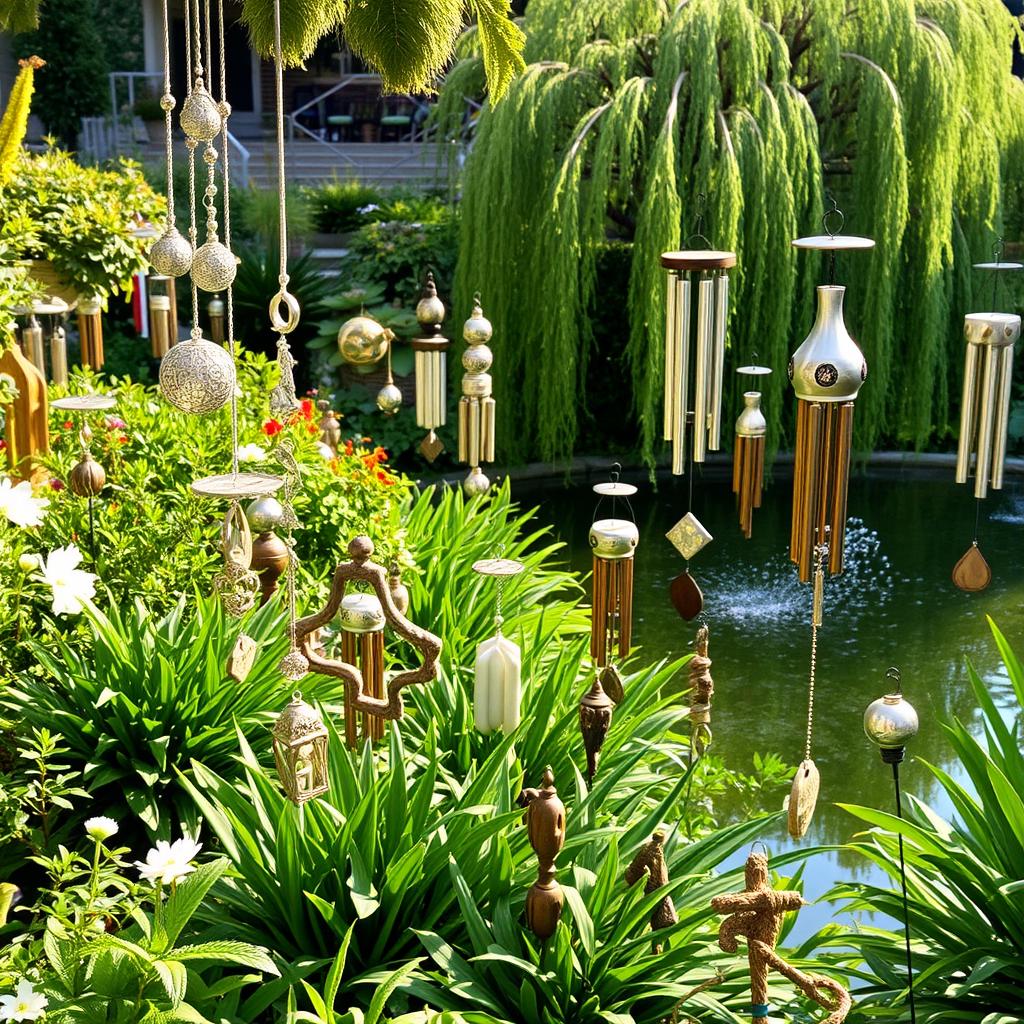
Wind chimes thrive in locations where air currents can freely dance around them. Most wind chimes begin to sing in winds between 6 to 10 mph, making their garden placement crucial for optimal performance.
Strategic Garden Placement Techniques
Select spots that offer unobstructed wind flow. Experts recommend hanging wind chimes at least two feet away from walls or large obstacles. Your porch, garden borders, or tree branches can serve as excellent mounting points.
Understanding Wind Direction Considerations
Prevailing winds typically blow east to west, but local microclimates can vary. Observe your garden’s unique wind patterns before selecting a permanent location. Deeper backyard areas might provide more consistent wind movement for your chimes.
Consider height and stability when installing. Shepherd hooks between 4 to 6 feet tall work well for most garden wind chimes. Ensure your chosen location allows the chimes to move freely and produce their enchanting sounds.
Seasonal Variations for Wind Chime Projects
Make your garden come alive with seasonal wind chimes. Each season brings a chance to create wind chimes that match nature’s changing colors and moods.
Spring wind chimes can be filled with soft colors and light materials. Think of a chime with green and pink elements that sway in the breeze. It’s a warm welcome to your garden’s new life.
Summer wind chimes are full of life with bright colors and shiny metals. Use shells, driftwood, or colorful glass for a fun sound in your outdoor space.
Autumn wind chimes have warm colors like rust and gold. Add fallen leaves, acorns, and twine for a wind chime that celebrates the harvest season’s beauty.
Winter wind chimes use frosty glass and silver for a calm look. They create a peaceful spot in your garden during the quiet months.
Switching your wind chimes with the seasons keeps your garden lively and connected to nature’s rhythm.
Common Mistakes to Avoid in Wind Chime Creation
Making DIY wind chimes is fun, but even pros can make mistakes. Knowing these errors helps you make wind chimes that sound great and look good in your garden.
Choosing the wrong materials is a big mistake. Lightweight metals like aluminum make different sounds than ceramic or wood. If you pick materials without thinking about sound, your wind chimes might not sound good.
Getting the string length wrong is another common mistake. If it’s too short, your wind chimes won’t sound right. If it’s too long, they might get tangled or hard to hang. Make sure to measure and test before you decide.
Not thinking about weather resistance is a big mistake. Your wind chimes need to last outside. Use materials that can handle rain, sun, and wind. Waterproof coatings and rust-resistant parts can help them last longer.
Getting the balance right is important. If your wind chimes are not balanced, they won’t move right and won’t sound good. Test them out and adjust them so they move smoothly and sound nice.
Conclusion
Your garden is about to get a lot better with DIY wind chimes. These have a long history, from ancient China to today’s designs. They add beauty, peace, and a personal touch that store-bought ones can’t.
Making your own wind chimes is easy and cheap. It lets you connect with a rich cultural history. You can make them with just $10 and recycled stuff. Each piece shows off your creativity and skill.
It’s a chance to create something beautiful that sounds and feels meaningful. Your DIY wind chimes will make your garden more inviting. They also offer a fun and calming crafting experience. Begin your wind chime journey today and see your garden become a peaceful, musical space.
Source Links
- Simple & Pretty Homemade Wind Chimes Kids Can Make! – https://handsonaswegrow.com/outdoor-music-diy-wind-chimes/
- How to Make Pressed Penny Wind Chimes (+ Sound File) – https://www.instructables.com/How-to-Make-Pressed-Penny-Wind-Chimes/
- Make Copper Wind Chimes | Chica and Jo – https://www.chicaandjo.com/make-copper-wind-chimes/
- How to make wind chimes—Rocks and water pipes make it hot ‣ MyFixitUpLife – https://myfixituplife.com/make-wind-chimes/
- Upcycle and Create Beautiful Polymer Clay Wind Chimes – https://keepsakecrafts.net/blog/2024/07/30/upcycled-wind-chimes-transforming-junk-into-garden-decor/
- Terracotta Flower Pot Wind Chime | Tutorial | – https://houseofjoyfulnoise.com/terracotta-flower-pot-wind-chime-tutorial/
- How to Use Wind Chimes to Enhance Your Backyard Privacy – https://calendulasgarden.com/how-to-use-wind-chimes-to-enhance-your-backyard-privacy/?srsltid=AfmBOoonLGkdmHVpqy2yRHy-ALg_KUF3w4Zc-1J6nS70sXB1MUQmhwz5
- 11 Wind Chime Ideas That Add Sound to the Breeze – https://www.livingspaces.com/inspiration/ideas-advice/decor-tips/wind-chime-ideas-that-add-sound-to-the-breeze
- Chime Design & Build – https://leehite.org/Chimes.htm
- Making Wind Chimes Ideas – https://www.pinterest.com/ideas/making-wind-chimes-ideas/956954397108/
- 10 DIY Wind Chimes To Enjoy The Sounds Of Nature – Shelterness – https://www.shelterness.com/diy-wind-chimes/
- How to Make a Rainbow Wind Chime from Recycled Cans – https://www.creativegreenliving.com/2015/03/how-to-make-rainbow-wind-chime-from-recycled-cans.html
- Eco-Friendly DIY: Unique Wind Chimes Craft – https://healing-sounds.com/blogs/wind-chimes/eco-diy-wind-chimes-recycled-materials?srsltid=AfmBOoqsHvSILvfToTCcDRzqsXN6YyWw2nB38L91-_YwNdWdpHVDvF_f
- DIY Recycled Wind Chimes Craft for Kids | Activities | GoGo SqueeZ® Blog – https://gogosqueez.com/blog/activity/gogo-beaded-wind-chime
- How to make Large Wind Chimes – Extreme Wind Chimes – http://www.extremewindchimes.com/make-large-wind-chimes/
- Crafting a One-of-a-Kind DIY Key Wind Chimes in 8 Steps – Craft projects for every fan! – https://craft.ideas2live4.com/2023/02/24/crafting-diy-key-wind-chime/
- 15 DIY Wind Chimes For a Relaxing Yard – https://www.thegardenglove.com/13-crafty-diy-wind-chimes/
- Wondering How To Make Wind Chimes? Get 10 Homemade Chime Ideas – https://bonito.in/blog/make-your-own-wind-chimes-10-amazing-diy-designs/
- Wind Ways – Wind Chimes • Beyond the Chalkboard – https://www.beyondthechalkboard.org/activity/wind-ways-wind-chimes/
- Repair & Refresh Broken Wind Chimes – https://www.myrepurposedlife.com/repair-refresh-broken-wind-chimes/
- Blown Away: 12 Upcycled Wind Chimes You Can Make – https://www.bobvila.com/slideshow/blown-away-12-upcycled-wind-chimes-you-can-make-47327/
- The Ultimate Guide to Hanging Wind Chimes: Tips and Techniques for Perfect Placement – MesidaBamboo – Premier Bamboo Products Specialist – https://bambooitem.com/the-ultimate-guide-to-hanging-wind-chimes-tips-and-techniques-for-perfect-placement/
- How to Choose the Perfect Wind Chime For Your Outdoor Space – https://inmyownstyle.com/how-to-choose-the-perfect-wind-chime-for-your-outdoor-space.html
- How to Hang Wind Chimes – https://www.thespruce.com/how-to-hang-wind-chimes-5248683
- Tips for Hanging Wind River Chimes to Maximize Sound & Enjoyment – https://windriverchimes.com/blogs/news/tips-for-hanging-wind-river-chimes-to-maximize-sound-enjoyment?srsltid=AfmBOoq0vyjLoGHRx4ZkSAxZW1Kp9XqhBs-L6FS0Xmx9RIRcx_Lq4SWX
- Homemade Nature Suncatcher Wind Chimes for Kids to Make – https://handsonaswegrow.com/nature-suncatcher-wind-chimes/
- Hang in There! 9 Unique Wind Chime and Mobile Ideas – https://www.travelcraftjournal.com/mobiles-and-wind-chimes/
- Make Your Own Edo Wind Chime — Must-Try Japanese Craft Workshop | Dana Yao – Travel Creator – https://danayao.com/make-your-own-edo-wind-chime/
- 194 Best Backyard Ideas To Unlock Your Garden’s Potential – https://trustyace.com/backyard-ideas/
- 300 Unique Galentine’s Day Party Ideas: Celebrate Friendship – https://www.julieannrachelle.com/blended-decor-blog/creative-themes-for-galentines-day-party
- DIY Wind Chime – https://dragonflyfun.com/diy-wind-chime/?srsltid=AfmBOooYWYrvzgtw6LZmVkDmZTOuovNQqMPmNg1riyBXC4WHdtnCkU8-
- 7 Amazing Home Decor Ideas to Explore Today! – Craft projects for every fan! – https://craft.ideas2live4.com/2019/08/03/diy-beaded-wind-chime/
- 30 Homemade DIY Wind Chimes to Make Your Own – https://www.diycraftsy.com/diy-wind-chimes/

